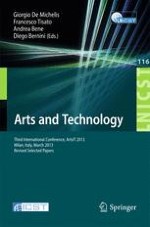2013 | Book
Arts and Technology
Third International Conference, ArtsIT 2013, Milan, Italy, March 21-23, 2013, Revised Selected Papers
Editors: Giorgio De Michelis, Francesco Tisato, Andrea Bene, Diego Bernini
Publisher: Springer Berlin Heidelberg
Book Series : Lecture Notes of the Institute for Computer Sciences, Social Informatics and Telecommunications Engineering
